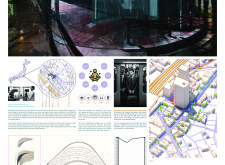5 key facts about this project
The design located in Arakawa City, Tokyo, emphasizes both the energetic atmosphere of urban life and the need for individual reflection. This space allows for social interaction while also providing areas for quiet contemplation. The concept seeks to blend the bustling nature of Tokyo with moments of mindfulness, reflecting the city's rich cultural background.
Spatial Organization
-
The arrangement of the space is designed for easy movement and interaction among users. Open paths guide people through the environment, enhancing opportunities for connection. Specific zones are created to support both group activities and personal quiet time. This layout effectively balances the need for community engagement with the importance of solitude.
Sensory Experience
-
The design pays special attention to engaging the senses. It invites users to experience their surroundings through sight, sound, smell, taste, and touch. By fostering this awareness, the space encourages visitors to connect with their environment more deeply. This approach is especially relevant in a lively city like Tokyo, where moments of calm can be hard to find.
Cultural Context
-
Situated in a culturally rich neighborhood, the design responds to the complexities of life in Tokyo. It embraces both contemporary and traditional elements, allowing the essence of the city to influence the architectural message. The project recognizes the challenges of urban living while providing areas that promote mindfulness and self-awareness, aligning with the varied experiences of its users.
Architectural Detail
-
To enhance the human experience, specific features highlight the play of light and shadow throughout the space. These elements create changing atmospheres that invite reflection at different times of day. The way light interacts with the design details encourages users to engage with both the space and their own thoughts, enriching their overall experience.



















































